|
A tuber is most often the first contact one has when getting Arisaema plants from friends or from the trade. Of course, it is not possible to identify a species just with a tuber in one’s hand. Nevertheless, there are some aspects about the tubers which may provide clues to mitigate this uneasiness. For instance, tubers of A. serratum and A. candidissimum are so different that they cannot be confused. A glance at a tuber will often tell you if an obvious mistake was made and, on the contrary, if this tuber may actually correspond to the expected species. Speaking scientifically, the tuber provides some necessary morphological clues for the correct identification, but not sufficient information to provide identification to the species level. A look at the shapes of Arisaema tubers and rhizomes in the different sections may help to illustrate these points to the reader.
Unfortunately, the external colour of the tubers is often the result of the way they were stored, away from light or not. On the contrary, inside, most tubers are creamy white and rhizomes are often purple.
You can learn more about Arisaema in the new book The Genus of Arisaema. A Monograph for Botanists and Nature Lovers by Guy and Liliane Gusman.
Click on the thumbnails for larger images and more information. Images with rulers indicate size in centimetres. All images Copyright © 2003 by Guy Gusman.
Arisaema Sections:
|
|
|
|
|
|
Anomala In this section, all species are evergreen and aseasonal. Petioles and peduncles emerge from a rhizome rooting all over. Roots are present everywhere along the rhizome. Usually the rhizome is internally colourd violet-purple. Its length may vary and, sometimes, very short rhizomes have been confused with tubers, such as in A. balansae. When leaves have been cut off for shipping, petiole and peduncle remains are still present.
|
|
|
|
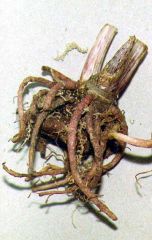 |
|
|
| Figure 3. A. victoriae has so short a rhizome that it could easily be confused with a tuber. |
|
|
|
|
|
|
|
|
|
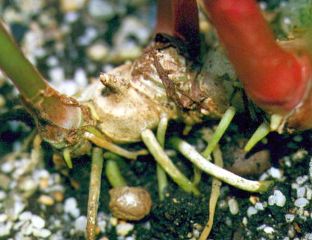 |
|
Figure 1. In A. filiforme , peduncles and petioles arise continuously from the rhizome but independently one from the other. |
|
|
|
|
|
|
|
|
 |
|
|
Figure 2. A. petelotii has huge rhizomes.
|
|
|
|
|
|
|
|
|
Arisaema Three different types of tubers are encountered:
1. The tuber is annulated, more or less elongate to ovoid in shape. The roots only surround the central shoot (Figures 4, 5, 6, and 7).
|
|
|
|
|
|
|
|
|
|
|
|
|
|
|
|
|
|
2. A second shape found in section Arisaema is the group A. dilatatum, A. elephas, A. wilsonii... where tubers are flattened on both upper and lower sides with many tuberlets soon developing their own roots and becoming independent of the mother tuber. The size may vary from small in A. elephas to huge in A. wilsonii.
|
|
|
|
|
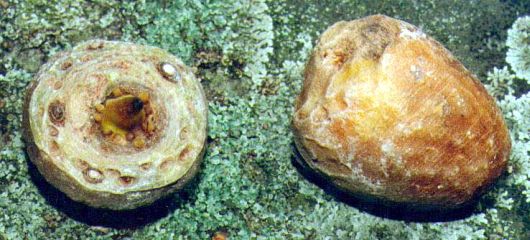 |
|
| Figure 9. The tubers of A. propinquum are not very different from those of A. dilatatum. |
|
|
|
|
|
|
|
|
|
|
|
|
|
|
|
|
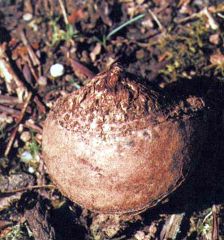 |
|
| Figure 10. A. costatum showing the typical, small rounded tuber. |
|
|
|
|
|
|
| 3. On the contrary, tubers of A. intermedium and A. costatum are more globose and quite small in comparison with the size of the plant. |
|
Clavata Tubers are subglobose. They look quite different if dry or when in growth.
|
|
|
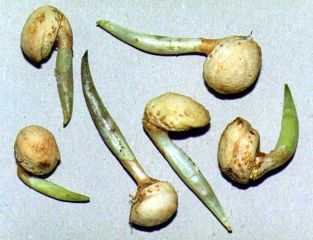 |
|
| Figure11. A. clavatum. Even flowering-sized tubers are rather small. |
|
|
|
|
|
|
|
|
 |
|
| Figure 12. As pointed out by Jin Murata, many accessory buds develop in the leaf axils of the Japanese A. heterocephalum. These tubers recall those of the group A. yunnanense. |
|
|
|
|
|
|
|
|
|
|
|
|
|
|
Decipienta Here again, we have rhizomes, rooting all over, but plants have a seasonal behaviour. As usual, there is one growing season a year, a pseudostem emerges generally early autumn.
|
|
|
|
|
|
Dochafa Tubers are small and subglobose.
|
|
Fimbriata Tubers of these seasonal and deciduous plants are subglobose and small – in comparison with the size of the plant – creamy white or yellowish inside and outside.
|
|
|
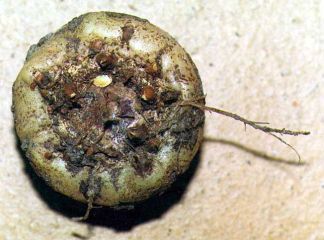 |
|
| Figure 15. A. fimbriatum. |
|
|
|
|
|
|
|
|
|
|
|
Flagellarisaema Two very different types of tubers are encountered.
|
|
|
|
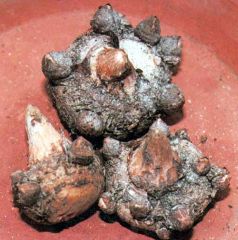 |
|
| Figure 17. A. thunbergii subsp. urashima - like all other subspecies of A. thunbergii - has tubers flat and very proliferous. |
|
|
|
|
|
|
 |
|
| Figure 18. Tubers of A. omeiense are very small and stoloniferous. |
|
|
|
|
|
|
|
|
Franchetiana In this section, tubers are easily recognizable, being flattened, often reddish and very bumpy.
|
|
|
|
 |
|
| Figure 20. Tuber of A. franchetianum, side view. |
|
|
|
|
|
|
|
|
|
|
|
|
|
|
|
|
|
|
|
|
|
|
|
 |
|
| Figure 22. Tubers of A. lobatum are subglobose, greenish, and have a conspicuous thick central shoot. |
|
|
|
|
|
|
|
|
| Lobata |
|
Nepenthoidea Tubers are flattened.
|
|
|
|
 |
|
| Figure 23. A. nepenthoides, shooting up at the beginning of the growing season. |
|
|
|
|
|
|
|
|
 |
|
| Figure 24. Tubers of A. wattii, still dormant and dry. |
|
|
|
|
|
|
|
|
Pedatisecta Tubers are subglobose - nearly round - with a conspicuous thick central shoot. Some are hardly proliferous, such as A. sikokianum; others, such as A. ovale, produce many offsets. One species only, A. ternatipartitum is stoloniferous.
|
|
|
|
 |
|
| Figure 26. A. tashiroi |
|
|
|
|
|
|
|
|
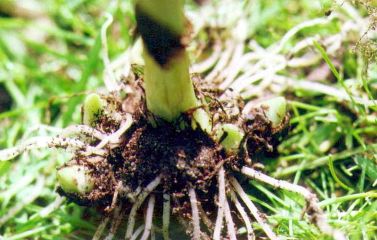 |
|
| Figure 27. A. ovale, showing many offsets. |
|
|
|
|
|
|
|
|
Sinarisaema In general, tubers are subglobose, some of them are stoloniferous. One species, recently introduced, has huge tubers whose shape recalls A. dahaiense.
|
|
|
|
|
|
|
 |
|
| Figure 29. The reddish roots of A. taiwanense are characteristic of the species. |
|
|
|
|
|
|
|
|
|
|
|
|
|
|
|
|
|
 |
|
| Figure 31. A. concinnum EMK 1068. Stolons emerge after flowering. |
|
|
|
|
|
|
|
|
|
|
|
|
|
|
|
|
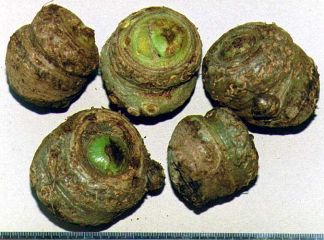 |
|
| Figure 32. A recent Chinese introduction from Gaoligong - a species still undescribed - with huge, cylindrical tubers, exceptional in Sinarisaema. |
|
|
|
|
|
|
Tenuipistillata They have small and subglobose tubers.
|
|
|
 |
|
| Fig. 33. A. jacquemontii |
|
|
|
|
|
|
|
|
|
Tortuosa Here, also, different types of tubers are encountered, subglobose and medium-sized in A. tortuosum, with many raised buds in the A. yunnanense complex and in A. negishii.
|
|
|
|
|
 |
|
| Figure 36. A. yunnanense. A crown of raised buds surrounds the central shoot like an annulus. |
|
|
|
|
|
|
|
|
|
|
|
|
|
|
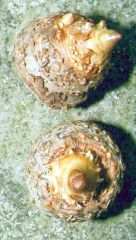 |
|
| Figure 37. A. negishii |
|
|
|
|
|
|
|
|
|
|
|
|
|
|
|
|
|
|
|
|
|
|
|
|
|
|
|
|
|
|
|
|
|
|
|
|
|
|
|
|
|
|
|


 Page design by Scott Hyndman for the I.A.S. on February 16, 2003.
Page design by Scott Hyndman for the I.A.S. on February 16, 2003.
